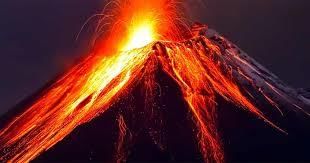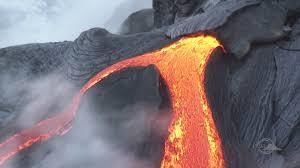Grade 7 Exam > Grade 7 Notes > Science for Grade 7 > Volcanoes
Volcanoes | Science for Grade 7 PDF Download
| Table of contents |

|
| Introduction |

|
| Volcanoes |

|
| Effects of Volcanoes |

|
| Why do people live near volcanoes? |

|
| Response to Volcanic Eruptions |

|
| Risk Mitigation |

|
Introduction
- A volcano is a hazard resulting from plate tectonics.
- Volcanic eruptions encompass primary effects, like building destruction, and secondary effects, such as causing homelessness.
- Strategies exist to mitigate the impact of volcanic eruptions, including planning, prediction, and preparation.
Volcanoes
- A volcano is a fissure in the Earth's crust where ash, magma, and gases are emitted. These eruptions pose risks to both people and the environment.
- Volcanic activities typically transpire either at the unstable boundaries of tectonic plates, which are segments of the Earth's crust, or within plate interiors where the crust is thin or at particularly hot spots in the mantle, the Earth's largest layer composed of hot, dense rock.
- When tectonic plates, the Earth's outer shell, interact, they can lead to volcanic eruptions due to the movement and pressure exerted at their boundaries.
- The mantle, situated beneath the Earth's crust, is responsible for generating magma that fuels volcanic eruptions. This layer consists of intense heat and dense rock materials.

Effects of Volcanoes
- A volcanic eruption can lead to various impacts, categorized as primary or secondary effects. Primary effects stem directly from the eruption, while secondary effects result from these primary impacts.
 When a volcano erupts it produces many hazards to life and property including lava flows
When a volcano erupts it produces many hazards to life and property including lava flows
Primary Effects
- During a volcanic eruption, lava flows from the volcano, causing destruction to habitats and properties.
- Lava is molten rock that surfaces from the Earth's crust. This molten rock, known as magma underground, can lead to severe damage.
- Pyroclastic flows, consisting of super-heated gas and ash, can move at high speeds, causing widespread devastation.
- Ash fallout from volcanoes can accumulate on structures, such as building roofs, potentially causing structural collapse.
Secondary effects
- Volcanic eruptions can have secondary effects on climate by altering atmospheric conditions like temperature and rainfall over time. This can contribute to global warming, a phenomenon where our climate is gradually becoming warmer. Ash from volcanoes can have a dual impact: it can reflect the sun's energy, leading to cooling effects, while the release of carbon dioxide can worsen global warming, an increase in atmospheric temperatures often influenced by human activities.
- Solidified lava flows from volcanic eruptions can block roads, making travel challenging and disrupting transportation routes.
- Despite the negative impacts, volcanic eruptions can also bring about positive effects. For instance, ash from the volcano can act as a natural fertilizer when deposited on soils, promoting plant growth and enhancing soil fertility.
Why do people live near volcanoes?
- People are attracted to live near volcanoes due to geothermal power, which involves generating electricity using the Earth's internal heat. This energy source is harnessed by utilizing steam from beneath the ground.
- Volcanic regions often attract many visitors, leading to the development of a thriving tourism industry. The unique landscapes and geological features draw tourists from around the world.
- The soil in volcanic areas is typically rich in minerals, making it highly fertile and suitable for agriculture. This richness in nutrients supports the growth of various crops and sustains agricultural activities.
Response to Volcanic Eruptions
When a volcano erupts, a country must take action. Responses can be immediate or long-term, depending on the situation.
Immediate Responses
- Evacuation of residents is crucial post-eruption or even beforehand if an eruption is anticipated.
- Establishing exclusion zones helps minimize casualties by restricting access to dangerous areas.
- Providing medical assistance to the injured is a priority.
Long-term Responses
- Reconstructing damaged structures and infrastructure essential for the country's operations, such as roads, water systems, and schools, is imperative.
- Resettling affected individuals may involve constructing new residences or relocating them to safer areas.
- Implementing monitoring devices aids in early detection of potential volcanic activities.
Question for VolcanoesTry yourself: What are the primary effects of a volcanic eruption?View Solution
Risk Mitigation
- Nations endeavor to diminish the impact of volcanic eruptions by trying to anticipate their timing, safeguarding structures, and preparing citizens on how to react during an eruption. The effectiveness of these measures varies based on a country's level of development.
- Wealthier countries, known as high-income countries (HICs) according to the World Bank's annual evaluation, can allocate more resources compared to lower-income countries (LICs), resulting in greater mitigation of adverse effects.
Prediction
- Volcanic eruptions are more predictable than earthquakes due to the ability to monitor seismic activity, energy release, earthquake frequency, and types.
- Tremors, which are lower level seismic readings, can indicate volcanic activity that may lead to an eruption.
- Observing changes in the shape of a volcano and monitoring gas emissions can also aid in predicting eruptions.
Protection
- It is challenging to protect buildings or land from volcanic eruptions, but restricting construction in high-risk areas can be a preventive measure.
- Areas deemed high-risk may have regulations prohibiting the construction of homes or other structures.
Preparation
- Training individuals on evacuation procedures before an eruption helps them get ready for such events. This could involve conducting drills in educational institutions or advising the public to assemble survival kits.
The document Volcanoes | Science for Grade 7 is a part of the Grade 7 Course Science for Grade 7.
All you need of Grade 7 at this link: Grade 7
|
75 videos|160 docs|52 tests
|
FAQs on Volcanoes - Science for Grade 7
| 1. Why do people choose to live near volcanoes? |  |
Ans. Some people choose to live near volcanoes because of the fertile soil and rich volcanic minerals that can support agriculture. Additionally, some communities have cultural or historical ties to the area surrounding the volcano.
| 2. What are the potential effects of volcanic eruptions? |  |
Ans. Volcanic eruptions can lead to various effects such as ash fall, pyroclastic flows, lahars (mudflows), volcanic gases, and lava flows. These can cause damage to infrastructure, agriculture, and endanger human lives.
| 3. How do scientists respond to volcanic eruptions? |  |
Ans. Scientists monitor volcanoes using various techniques such as seismometers, gas sensors, and satellite imagery to predict eruptions and provide early warnings to communities at risk. They also conduct research to better understand volcanic activity.
| 4. What are some ways to mitigate the risks associated with living near volcanoes? |  |
Ans. Risk mitigation strategies for living near volcanoes include building structures resistant to volcanic hazards, establishing evacuation plans, educating communities about volcano preparedness, and conducting regular drills and exercises.
| 5. How do volcanic eruptions impact the environment and climate? |  |
Ans. Volcanic eruptions can release large amounts of ash and gases into the atmosphere, which can affect air quality, temperature, and weather patterns. The release of sulfur dioxide can lead to the formation of sulfuric acid aerosols, which can cool the Earth's surface.
Related Searches














